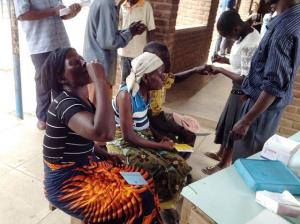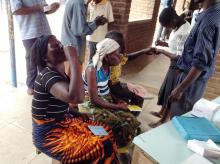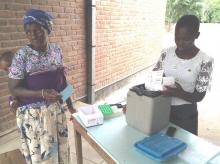Malawi completes round one of the oral cholera vaccination campaign in Nsanje District
Lilongwe 13 April 2015: From 30 March to 4 April 2015 the Ministry of Health and partners completed the first round of the Oral Cholera Vaccination (OCV) campaign in the southern district of Nsanje which borders with Mozambique.
The campaign has targeted 160,000 people that are living in camps and the surrounding villages as an additional measure to prevent and control the spread of cholera which started on 11 February 2015. The preliminary results of the campaign show that over 143,000 people were vaccinated representing close to 89% coverage.
The main reason for WHO’s recommendation for Malawi to use the OCV was that the extensive flooding that happened in January caused 230,000 people to be displaced and forced them to live in tents and other temporary shelters where sanitation and hygiene practices continue to be a challenge. The oral cholera vaccination campaign is part of a strategy to prevent the outbreak from reaching Internally Displaced People (IDP) living in camps. The vaccine being used is called Shanchol and is a WHO prequalified vaccine (2011). It is available in single dose 1.5 ml vials and is administered in two doses orally with an interval of two to six weeks.
In collaboration with the International Vaccine Institute the World Health Organization led the design and planning process and also participated in the implementation of the Oral Cholera Vaccine in Malawi. Specifically, WHO provided vaccines for 105000 people while the International Vaccine Institute provided vaccines for 55000 people. The World Health Organization is continuing to lead the monitoring, evaluation and documentation of the best practices in the introduction of the Oral Cholera Vaccine.
The vaccine was administered to all persons over one year who are living in camps and the surrounding communities in Nsanje district. The second dose will be administered from 20 to 25 April 2015.
The channels of communication used to mobilize the people were radios, village criers, mobile communication vans and village meetings. The message to the beneficiaries of the oral cholera vaccine emphasized that although the vaccine could prevent people from catching the disease, use of safe drinking water, toilet use, hand washing with soap and the food hygiene practices remain paramount interventions to stop the spread of cholera outbreak.
The community response to the OCV campaign was positive as evidenced by the high turn up of people to numerous sites that were set up by Nsanje District Health Office such as schools, health posts, camps and other suitable places where people were able to reach and receive the vaccine.
_________________________________________
For more information contact:
Mr. H.W. Kubwalo, World Health Organization
Tel: 01 772 755
Email: afwcomw [at] who.int (afwcomw[at]who[dot]int)
_________________________________________
01. The cholera vaccine is taken orally as seen in the photograph above
02. A woman is holding a blue card as evidence of receiving the first dose of oral cholera vaccine


